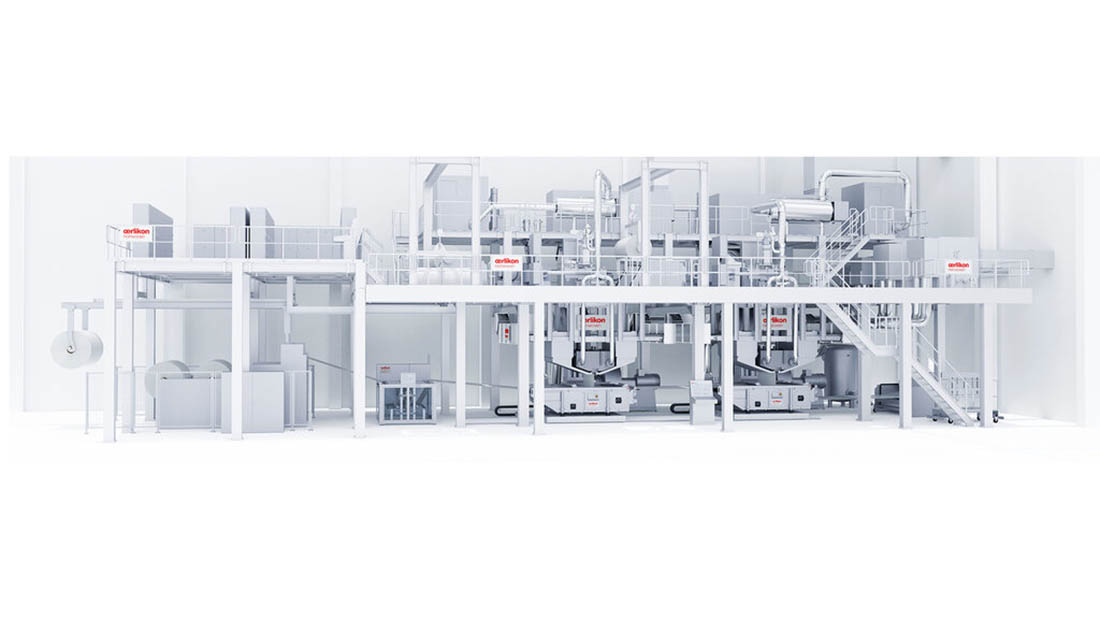Oerlikon Nonwoven is exhibiting at INDEX in Geneva, Switzerland, Oct 19-22, 2021 (booth #2314), focusing on market- and customer-oriented system solutions for filtration, hygiene, medical, geotextile and other industrial applications.
Oerlikon Nonwoven’s meltblown technology handles polymers used to produce the filter media and membranes. The spectrum ranges from classical polyolefins (PP, PE), PET, PLA, PBT and PA all the way through to special plastics such as PPS and TPU. All these and other raw materials can be reliably processed using the Oerlikon Nonwoven meltblown procedures. And the ecuTEC+ electro-charging unit electrostatically charges filter media in order to further increase filter efficiency. It distinguishes itself from other concepts currently available on the market as a result of its extreme flexibility. Users can choose from numerous possible variations and to set the optimum charge intensity for their respective filter applications.
For industrial nonwovens, Oerlikon Nonwoven systems are capable of high production capacities and yields with simultaneously low energy consumption. To this end, geotextiles made from polypropylene or polyester can be efficiently manufactured with running meter weights of up to 400 g/m2 and filament titers of up to 9 dtex, for example. And Oerlikon Nonwoven also offers specialized spunbond processes for producing nonwoven substrates for roofing underlays (PP or PET spunbonds) and so-called bitumen roofing substrates (needled PET spunbonds) for bitumen roofing membranes.
Furthermore, spunbond products are also becoming increasingly important in filtration applications – both as backing materials for filter media and as the filter media themselves. A flexible nonwoven structure permits the inclusion of customer-specific requirements for various functions. It is Oerlikon Nonwoven’s many years of core-sheath bi-component experience in particular that enable the creation of completely new nonwoven structures and hence the incorporation of various functions in a single material. The core-sheath bi-component spinning process permits various combined fiber cross-sections and also simultaneously different fibers to be produced from a single or different polymers. The spectrum ranges from core-sheath and side-by-side bi-component filaments, splitable fibers all the way through to so-called mixed fibers.
For manufacturing hygiene and medical nonwovens, the QSR (Quality Sized Right) technology offers an economical solution for producing these highly diverse spunbond and meltblown composites (SSMMS, SMMS, SSS, etc.) in accordance with globally accepted standards.
With its Phantom platform, Oerlikon Nonwoven offers an alternative coform technology for manufacturing various wet wipes from pulp and polymer fibers. Here, the spunmelt and airlaid processes are combined in a manner that perfectly unites the properties of the starting materials. The material mix can comprise up to 90% cellulose fibers. Alternatively, cotton or synthetic fibers can also be added.
Compared to processes such as classical spunlace (hydroentangled carded nonwovens) produced to date, the Phantom technology offers ecological, performance and cost advantages. Dispensing with hydroentanglement renders subsequent drying of the material redundant. Product parameters, such as softness, tenacity, dirt absorption and liquid absorption, can be optimally set. The Phantom technology enables the manufacture of both flexible and absorbent structures and highly-textured materials.
Pulp or cellulose fibers as raw material for manufacturing nonwovens are currently virtually unrivaled with regards to sustainability and environmental compatibility. The Oerlikon Nonwoven airlaid process enables the manufacturing of high-quality, lightweight airlaid nonwovens with economical production speeds and system throughputs. Here, the patented Oerlikon Nonwoven formation process enables homogeneous fiber laying and evenness, even for nonwovens with low running meter weights. Furthermore, it permits the homogeneous mixing of the most diverse raw materials, including pulp, short- and long-staple natural and manmade fibers (up to 20 mm) and powders, as well as the utilization and combination of the most diverse mechanical, thermal and chemical tangling methods for creating the requisite product properties.


